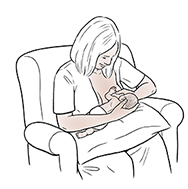Breastfeeding Your Premature Infant at Home
Breastfeeding Your Premature Infant at Home
Until now, your baby has been cared for in the NICU (neonatal intensive care unit). You’ve started breastfeeding. And you are now ready to move on to full breastfeeding at home. This sheet can answer some of your questions about making this transition.
"Laid-back" position |
"Football hold" |
"Cross-cradle hold" |
Preparing for your baby’s discharge
Pump more milk than needed. This helps stimulate your body to make as much milk as possible. The more milk you’re producing, the easier it is for your baby to feed.
Find out your baby’s weight at the time he or she leaves the NICU. This will help you keep track of whether your baby is gaining weight at home.
Breastfeeding at home
Keep using positions recommended for preemies until the baby weighs at least 5 to 6 pounds. (See below for more on these positions.)
Aim to feed your baby 8 to 12 times a day. You may be advised to feed your baby when he or she seems to be hungry, not on a fixed schedule. This helps avoid tiring the baby. But in some cases, a fixed schedule is needed to make sure the baby is getting enough to eat. Your baby should be fed between scheduled feedings if he or she seems hungry.
Your baby should take as much milk as possible from 1 breast before switching to the other. This is because hindmilk (the last milk to flow from the breast) is richer in fat and calories than the milk that flows at first.
Many healthcare providers recommend pumping in addition to nursing your infant. This helps build up your milk supply.
If you have been prescribed supplements for your baby, talk to your healthcare provider about the best way to add these to your baby's feedings.
How do I know if my baby is getting enough to eat?
Your healthcare provider should evaluate your baby’s milk intake soon after discharge. This can be done either at an office visit or by phone. To make sure your baby is eating enough:
Count wet diapers and stools. The baby should have 8 wet diapers a day, and at least 1 bowel movement each day.
Listen to make sure that your baby is swallowing during feedings. If not, the baby may be suckling but getting little or no milk.
After a feeding, your breasts should feel softer and empty. Your baby should seem satisfied.
Your baby will be weighed at your healthcare provider’s office at each visit. You may also want to weigh your baby on an infant scale at home.
If you’re having problems breastfeeding, contact a lactation consultant. Or try a local breastfeeding support organization. This can be especially helpful if you’re nursing more than 1 baby.
Can I expect problems with breastfeeding because of prematurity?
Preemies may have trouble breastfeeding at first. These problems usually get better as the baby matures. Problems you may see include:
Difficulty getting the nipple placed correctly in the mouth
Falling asleep at the breast early in feeding
Difficulty coordinating suckling, swallowing, and breathing
A weak suckle (difficulty getting enough milk even during a long feeding)
Unpredictable sleeping patterns
Breastfeeding positions
Preemies need to feed in positions that provide extra support for the neck and head. These are the safest positions for nursing preemies:
"Laid-back" position
Lie back in a chair, with your body on a 45-degree angle. In this position, your chest is a good place for your baby to move around on his or her tummy. Your baby's whole body is supported. He or she can use reflexes to move toward your nipple, find the nipple, and start to nurse. This will be the most comfortable position for both of you. You will have a hand free because your body is holding the baby.
The “football hold”
Place a pillow at your side next to the breast you’re going to use. Lay the baby on the pillow at breast height. Place the back of the baby’s head in the palm of your hand. Use your forearm to support the shoulders and spine. Tuck the baby’s legs between your arm and body. If you’re nursing twins, you may be able to use this hold to nurse both babies at once.
The “cross-cradle hold”
Put a pillow in your lap, and lay your baby across your lap at breast height. Support the baby’s head and neck with the hand and arm opposite the breast you’re using. Hold the baby’s head just below the ears, at the nape of the neck. Use your other hand to support your breast.
Updated:
February 13, 2018
Sources:
American Academy of Pediatrics. Breastfeeding and the use of human milk. Pediatrics. 2012;129(3):e826-842
Reviewed By:
Adler, Liora C, MD,Freeborn, Donna, PhD, CNM, FNP


